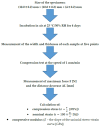Comparison of Two Chosen 3D Printing Resins Designed for Orthodontic Use: An In Vitro Study
- PMID: 36984116
- PMCID: PMC10053969
- DOI: 10.3390/ma16062237
Comparison of Two Chosen 3D Printing Resins Designed for Orthodontic Use: An In Vitro Study
Abstract
(1) Background: In recent years, 3D printing has become a highly popular tool for manufacturing in various fields such as aviation, automobiles, plastics, and even medicine, including dentistry. Three-dimensional printing allows dentists to create high-precision models of teeth and jaw structure, and enables them to develop customized tools for patients' treatment. The range of resins used in dentistry is quite large, and this branch is developing rapidly; hence, studies comparing different resins are required. The present study aimed to compare the mechanical properties of two chosen resins used in dentistry. (2) Materials and methods: Ten specimens each of two types of 3D-printable resins (BioMed Amber and IBT, developed by Formlabs) were prepared. The samples were printed on a Formlabs Form 2 3D printer according to ISO standards. Samples for the compression test were rectangular in shape (10 ± 0.2 mm × 10 ± 0.2 mm × 4 ± 0.2 mm), while the samples used for the tensile test were dumbbell shaped (75 mm long, with 10 mm end width and 2 mm thickness). Tensile and compression tests of both materials were performed in accordance with the appropriate ISO standards. (3) Results: The BioMed Amber resin was more resistant to compression and tensile forces, thus implying that the resin could withstand higher stress during stretching, pulling, or pushing. The IBT resin was less resistant to such loads, and failure of this material occurred at lower forces than those for Biomed Amber. An ANOVA test confirmed that the observed differences were statistically significant (p < 0.001). (4) Conclusions: Based on the properties of both materials, the IBT resin could be better used as a tray for placing orthodontic brackets through an indirect bonding technique, while the BioMed Amber resin would be more useful as a surgical guide for placing dental implants and mini-implants. Further potential fields of application of the resins should be investigated.
Keywords: 3D printing in dentistry; compression; dental materials; resins; tensile.
Conflict of interest statement
The authors declare no conflict of interest.
Figures






References
-
- Grzebieluch W., Kowalewski P., Grygier D., Rutkowska-Gorczyca M., Kozakiewicz M., Jurczyszyn K. Printable and Machinable Dental Restorative Composites for CAD/CAM Application—Comparison of Mechanical Properties, Fractographic, Texture and Fractal Dimension Analysis. Materials. 2021;14:4919. doi: 10.3390/ma14174919. - DOI - PMC - PubMed
Grants and funding
LinkOut - more resources
Full Text Sources

